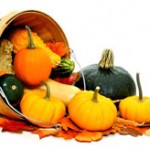And How to Make the Most of Them
 The days are getting shorter, the nights are getting colder, and there’s a pile of leaves to rake.
The days are getting shorter, the nights are getting colder, and there’s a pile of leaves to rake.
The arrival of fall brings with it a host of changes in our everyday activities that can potentially impact our health in negative ways. We might spend less time active outside, gravitate toward fattening “comfort” foods, and generally suffer from reduced exposure to sunlight.
So, in the spirit of the (spooky) season, here are some things to bear in mind.
1) It’s Halloween
It truly is horrifying, the torment that comes with trick or treating, as least as far as your teeth and pancreas are concerned. All that sugar—bad for your teeth and even worse for your waistline, mood, and energy levels.
Your pancreas is that mysterious organ hiding behind your stomach. Part of its function is to produce the hormones that manage your blood sugar levels, including insulin. When you eat too much sugar, your pancreas responds by pumping out more insulin to absorb the excess glucose in the blood and stabilize sugar levels. The problem is, that quick energy is followed by a crash that can leave you feeling drained and foggy.
Persistent overconsumption of sugar can also age your body prematurely, increase cravings, raise your blood pressure, damage your liver, and of course, lead to obesity and the onset of Type II Diabetes.
All these negative effects apply to kids as much as they do adults. How much sugar should you eat? Ideally, none, but that’s of course no fun. So, aim for moderation. Halloween candy comes in those handy bite sizes, after all. Limit yourself to one or two a day, as opposed to, say, per hour.
2) And it’s flu season
Reduced exposure to sunlight reduces your body’s production of vitamin D. Vitamin D helps our bodies absorb other essential minerals for strong bones and teeth and resistance to illness.
The best defence is a good offense – stock up on a quality vitamin D supplement. The best form of vitamin D is D3, also known as cholecalciferol.
3) Don’t rack your back with that rake
All those pretty leaves end up as a mess to clean up. If you need to rake some areas of the lawn, take the usual precautions to avoid a strain or injury:
- Stretch your back and shoulders before and after.
- Practice your footwork—don’t overreach.
- Squat and lift from the knees instead of bending over.
- Make the job easier with a leaf blower and a wheelbarrow.
4) And don’t get SAD
Months of cold and gloomy weather can take its toll if you don’t relish outdoor winter activities. We see less sun, we may be deficient in key nutrients, and the appeal of comfort foods (spiced pumpkin latte, anyone?) may have us consuming more of that sugar which can impact mood and energy levels.
What can you do? Again, make sure you get enough vitamin D. Get out in the fresh air, even if just for a walk, especially when the sun is out. And lay off those sweet treats.
Exercise is always a great mood enhancer at any time of year. Regular exercise promotes neural growth in the brain and feelings of calm and well-being by sparking the release of feel-good chemicals known as endorphins. It also reduces inflammation and helps to flush toxins from your system. Exercise can also serve as a form of meditation, to give you a period of peace and quiet and focus. You end up sleeping better, feeling better, and having more energy throughout the day.
In fact, exercise has proven to be an effective aid for battling mild-to-moderate depression, anxiety, and ADHD, without the need for drugs and their associated side effects, at any time of year.
